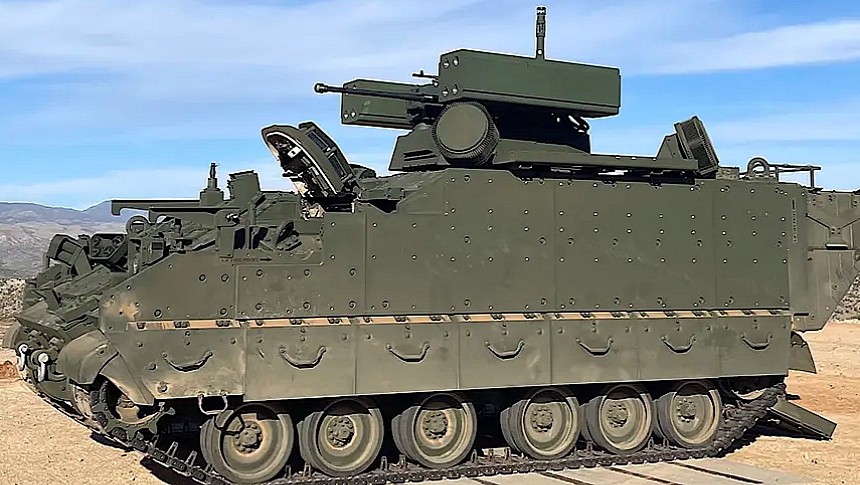Drones of all shapes, sizes, and kinds have certainly become the stars of modern-day battlefields. In all of the world's hotspots, they are used on land, in the air, and on water to inflict unexpected and most of the time serious damage to the enemy and its assets.
You only have to look at the efforts the world's militaries are making to counter drones to realize that's so. On more than one occasion, we've seen defense contractors scramble to come up with solutions against these growing threats, some with a bit more success than others.
One of the latest companies to join the fray is British company BAE Systems. It's a group that was tasked by the U.S. Army, among other things, to make the replacement for the M113 tracked armored personal carrier.
The M113 has been in service ever since the 1960s, and that makes it old on many levels – and that's saying something, given how the military is used to deploy decades-old tech. Like with several other pieces of old hardware in the inventory, the M113 is about to be replaced by a newer vehicle.
That would be the BAE Systems Armored Multi-Purpose Vehicle (AMPV), which at the end of last year was selected by the U.S. in five different variants, all to be fielded by Armored Brigade Combat Teams (ABCT): General Purpose, Mortar Carrier, Mission Command, Medical Treatment and Medical Evacuation.
As you can see, none of the above variants includes any anti-drone capability. Yet that's exactly what BAE tested in a live fire exercise conducted at an undisclosed point in time at the Big Sandy range in Kingman, Arizona.
A sixth AMPV variant, a prototype, was equipped with something called the External Mission Equipment Package (ExMEP) top plate. It's a system that allows the installation of various technologies, up to 30 different turrets, including the one called the Reconfigurable Integrated-weapons Platform (RIwP) turret.
Built by a defense contractor called Moog, the RiwP comprises the Multi-Mission Hemispheric Radars (MHR, made by Leonardo) and the XM914 30 mm cannon (made by Northrop Grumman).
With this setup on, the AMPV Counter-Unmanned Aircraft System, as it is known, had to survive various realistic battlefield scenarios during the test. It was used to detect, track, identify, and defeat drone and stationary targets using proximity rounds. That meant firing at both mock enemies on the ground, but also drones flying overhead.
We're not given the exact specifics of the test, given its nature, and neither are we told anything about when such a version of the AMPV might enter service. The company behind the project however makes a promise that "this is just the beginning of what you'll see from the AMPV."
One of the latest companies to join the fray is British company BAE Systems. It's a group that was tasked by the U.S. Army, among other things, to make the replacement for the M113 tracked armored personal carrier.
The M113 has been in service ever since the 1960s, and that makes it old on many levels – and that's saying something, given how the military is used to deploy decades-old tech. Like with several other pieces of old hardware in the inventory, the M113 is about to be replaced by a newer vehicle.
That would be the BAE Systems Armored Multi-Purpose Vehicle (AMPV), which at the end of last year was selected by the U.S. in five different variants, all to be fielded by Armored Brigade Combat Teams (ABCT): General Purpose, Mortar Carrier, Mission Command, Medical Treatment and Medical Evacuation.
As you can see, none of the above variants includes any anti-drone capability. Yet that's exactly what BAE tested in a live fire exercise conducted at an undisclosed point in time at the Big Sandy range in Kingman, Arizona.
A sixth AMPV variant, a prototype, was equipped with something called the External Mission Equipment Package (ExMEP) top plate. It's a system that allows the installation of various technologies, up to 30 different turrets, including the one called the Reconfigurable Integrated-weapons Platform (RIwP) turret.
Built by a defense contractor called Moog, the RiwP comprises the Multi-Mission Hemispheric Radars (MHR, made by Leonardo) and the XM914 30 mm cannon (made by Northrop Grumman).
With this setup on, the AMPV Counter-Unmanned Aircraft System, as it is known, had to survive various realistic battlefield scenarios during the test. It was used to detect, track, identify, and defeat drone and stationary targets using proximity rounds. That meant firing at both mock enemies on the ground, but also drones flying overhead.
We're not given the exact specifics of the test, given its nature, and neither are we told anything about when such a version of the AMPV might enter service. The company behind the project however makes a promise that "this is just the beginning of what you'll see from the AMPV."






